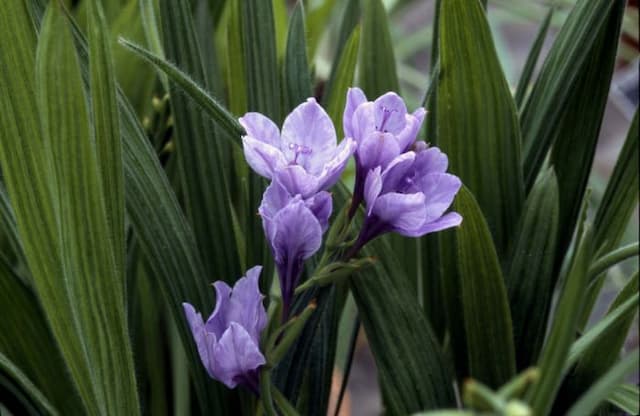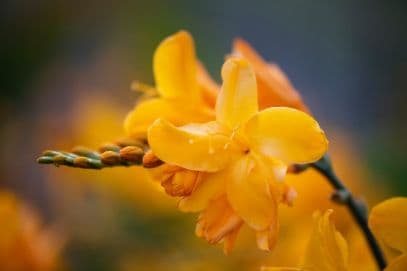Japanese water iris Iris laevigata

ABOUT
The plant known as the Japanese iris boasts an elegant and striking appearance. This plant is highlighted by its beautiful flowers which typically exhibit a rich blue hue, although they can sometimes be found in shades of white or purple. The flowers are characterized by their flat, spreading petals that often display a slight ruffling along the edges, and they posses a unique charm with a small, yellow or white pattern in the center, which contrasts vividly against the petal's color. These blooms are quite large, adding to the plant's visual impact. The foliage of the Japanese iris is another attractive feature, with long, slender, sword-like leaves that grow upright and form dense clumps. The leaves have a fresh green color which provides a striking backdrop to the showy blooms. The plant itself has a clumping habit, adding to the lush appearance of the plant in a garden setting. Its leaves stay attractive even when the plant is not in bloom, giving it a graceful and structured look throughout the growing season. The Japanese iris is not only appreciated for its stunning flowers but also its ability to thrive in wet conditions, making it an ideal plant for water gardens or along the edges of ponds where the reflection of its flowers can double the beauty. This plant has an overall aesthetic that is both sophisticated and natural, making it a beloved choice among gardeners looking to create a serene and picturesque landscape.
About this plant
 Names
NamesFamily
Iridaceae
Synonyms
Rabbit-Ear Iris, Kakitsubata, Shallow-flowered Iris
Common names
Iris albopurpurea, Iris phragmitetorum, Limniris laevigata, Xyridion laevigatum.
 Toxicity
ToxicityTo humans
Iris laevigata, commonly known as Japanese iris, is not typically considered to be a highly toxic plant to humans. However, it is worth noting that irises contain compounds that may cause irritation. If ingested, parts of the plant—particularly the rhizomes, which contain the highest concentration of these irritating substances—can cause mild stomach upset. Symptoms, if they occur, may include nausea, vomiting, abdominal pain, and diarrhea. Handling the plant can sometimes lead to skin irritation as well.
To pets
Japanese iris, or Iris laevigata, may pose a danger to pets if ingested. The plant contains irisin, iridin, or irisine, which are substances that can cause gastrointestinal irritation in animals. Symptoms of poisoning in pets from eating parts of the iris may include drooling, vomiting, diarrhea, or abdominal pain. More severe cases of ingestion might lead to increased severity in symptoms and could warrant veterinary attention. Pet owners should be cautious and prevent their animals from consuming this plant.
 Characteristics
CharacteristicsLife cycle
Perennials
Foliage type
Deciduous
Color of leaves
Green
Flower color
Blue
Height
2 feet (60 cm)
Spread
2 feet (60 cm)
Plant type
Bulb
Hardiness zones
4
Native area
Asia
Benefits
 General Benefits
General Benefits- Water garden aesthetics: Iris laevigata, known as Japanese iris, is prized for its ornamental value, adding striking color and distinctive form to water gardens and ponds.
- Habitat support: Its presence in aquatic environments provides habitat and breeding grounds for various aquatic insects and amphibians.
- Erosion control: The roots help stabilize soil in wet areas, preventing erosion along pond edges and in water gardens.
- Low maintenance: As a hardy perennial, Japanese iris requires minimal care once established, making it a convenient choice for gardeners.
- Pollinator attraction: The flowers attract bees and other pollinators, promoting biodiversity and the health of nearby plants.
- Seasonal interest: It offers seasonal interest with vibrant blooms in late spring to early summer, enhancing the visual appeal of landscapes during this time.
- Cultural significance: Japanese iris is deeply embedded in Japanese culture and art, symbolizing elegance and purity, and is celebrated during Hanashōbu festivals.
 Medical Properties
Medical Properties- Diuretic: Iris laevigata is traditionally used to promote urination and relieve water retention.
- Detoxification: It has been used historically in certain cultures to detoxify and purify the blood.
- Anti-inflammatory: Components within the plant may have inflammation-reducing properties.
- Skin ailments: Historically used in the form of pastes or poultices for treating skin issues.
 Air-purifying Qualities
Air-purifying QualitiesThis plant is not specifically known for air purifying qualities.
 Other Uses
Other Uses- Iris laevigata, commonly referred to as the "Japanese Iris," has been used traditionally in Japanese gardens for its aesthetic appeal, particularly around ponds and water features where it thrives in moist conditions.
- The tough, fibrous leaves of the Japanese Iris can be woven into mats, ropes, and other handicrafts due to their strength and durability.
- In certain cultures, the flowers of the Japanese Iris are used as a natural dye, giving textiles a delicate blue or purple hue.
- The plant plays a role in floristry as a popular choice for bouquets and floral arrangements, often symbolizing good news and compliments.
- Dried Japanese Iris rhizomes are sometimes included in potpourri mixes for their subtle fragrance and ornamental appeal.
- Gardeners sometimes use the rhizomes of the Japanese Iris to create natural barriers or edges along garden paths, benefiting from their spreading nature.
- The seed pods of the plant can be used for craft purposes, such as making decorative items or as additions to artistic installations.
- Japanese Iris plants have been subjects of painting and other forms of art, especially in East Asian cultures, symbolizing elegance and purity.
- Educational use in horticultural programs or botany studies due to this species' specific water and soil requirements that provide learning opportunities about plant ecology.
- The plant is used in breeding programs to create new cultivars with enhanced ornamental features, such as unique flower colors and shapes.
Interesting Facts
 Feng Shui
Feng ShuiThe Japanese iris, which is another name for Iris laevigata, can be used in Feng Shui to add a water element because it is often found near water in the wild. It may help balance the energy in a garden or outdoor space, especially in areas related to wealth (southeast) or career (north). However, it must be placed in a balanced way not to overwhelm a space with water energy.
 Zodiac Sign Compitability
Zodiac Sign CompitabilityThe Japanese iris is not used in astrology practice.
 Plant Symbolism
Plant Symbolism- Faith: The iris typically symbolizes faith, inspiring trust and belief in something beyond the physical world.
- Wisdom: It is often associated with wisdom, representing knowledge, intelligence, and good judgement.
- Hope: Another common symbolism is hope, embodying the anticipation of positive outcomes and future happiness.
- Purity: The striking appearance of the iris, particularly in white variations, conveys purity and innocence.
- Royalty: With its regal bearing and association with the French monarchy, the iris can symbolize nobility and regal splendor.
 Water
WaterThe Japanese Iris should be kept consistently moist, especially during the growing season. This plant thrives in wet conditions, so it's essential to water it deeply at least once a week, and more frequently during periods of drought or high heat. Depending on weather conditions and soil moisture, the plant might need between 1 to 2 gallons of water per week. Ensure the soil never completely dries out, as Japanese Iris enjoys moist, well-drained soils.
 Light
LightJapanese Iris prefers full sun to partial shade. The best spot for this plant would be a location where it receives a minimum of six hours of direct sunlight daily. However, in extremely hot climates, providing some afternoon shade will help protect the plant from intense, potentially damaging heat.
 Temperature
TemperatureJapanese Iris thrives in temperate environments and is hardy in USDA zones 4 through 9. The ideal temperature range for this plant is between 68°F to 85°F, but it can tolerate winter temperatures down to -20°F and summer temperatures up to 90°F. It's important to protect the plant from extreme heat by offering partial shade and ensuring adequate moisture.
 Pruning
PruningJapanese Iris benefits from pruning to remove spent flowers and to promote healthy growth for the following season. The best time to prune is after blooming, in late summer. Deadhead the flowers and cut back any damaged or diseased foliage. Pruning should be done annually to encourage vigorous growth and maintain plant health.
 Cleaning
CleaningAs needed
 Soil
SoilJapanese Iris (Iris laevigata) thrives in acidic soil with a pH of 5.0-6.5. The ideal soil mix should be rich, loamy, and well-draining, with plenty of organic matter. Peat moss, compost, and pine bark can be combined to create an acidic environment conducive to the plant's growth.
 Repotting
RepottingJapanese Iris should be repotted every 2-3 years to prevent overcrowding and promote healthy growth. The best time to repot is just after the flowering season when the plant is dormant.
 Humidity & Misting
Humidity & MistingJapanese Iris enjoys high humidity levels, ideally between 60-70%. They thrive in moist environments, making them well-suited to waterside plantings where the ambient humidity is naturally higher.
 Suitable locations
Suitable locationsIndoor
Plant in acidic soil, keep moist, provide bright, indirect light.
Outdoor
Plant in moist, acidic soil with full sun to partial shade.
Hardiness zone
4-9 USDA
 Life cycle
Life cycleIris laevigata, commonly known as the Japanese iris, begins its life cycle with seed germination, which requires a period of cold stratification to break dormancy. Upon germination, the seedlings establish a rosette of leaves and form rhizomes, which serve as energy storage organs. Over the next few years, the plant will grow and mature, producing taller leaves and multiplying through the rhizome to increase its clump size. The Japanese iris typically blooms in late spring to early summer, displaying showy flowers that attract bees and other pollinators for sexual reproduction. Once fertilized, the flowers produce capsules containing seeds that, when mature, are dispersed nearby or transported by water, as the plant often grows in wet conditions. The life cycle completes when these seeds germinate to start the process anew or when the rhizomes send up new shoots.
 Propogation
PropogationPropogation time
Spring to Summer
The most popular method of propagating the Iris laevigata, commonly known as the Japanese iris, is through division of its rhizomes. This is typically done in late summer after the flowering period has ended, generally in August or September. To propagate by division, carefully dig up the clump of irises and use a sharp knife to separate the rhizomes, ensuring each division has at least one fan of leaves and a section of roots. Trim the leaves to about 6 inches (15 centimeters) to reduce water loss. Replant the divisions 12 to 24 inches (30 to 60 centimeters) apart, setting the rhizome so the top is slightly below the soil surface. Water thoroughly to settle the soil around the roots and provide a strong start for the new plants.









